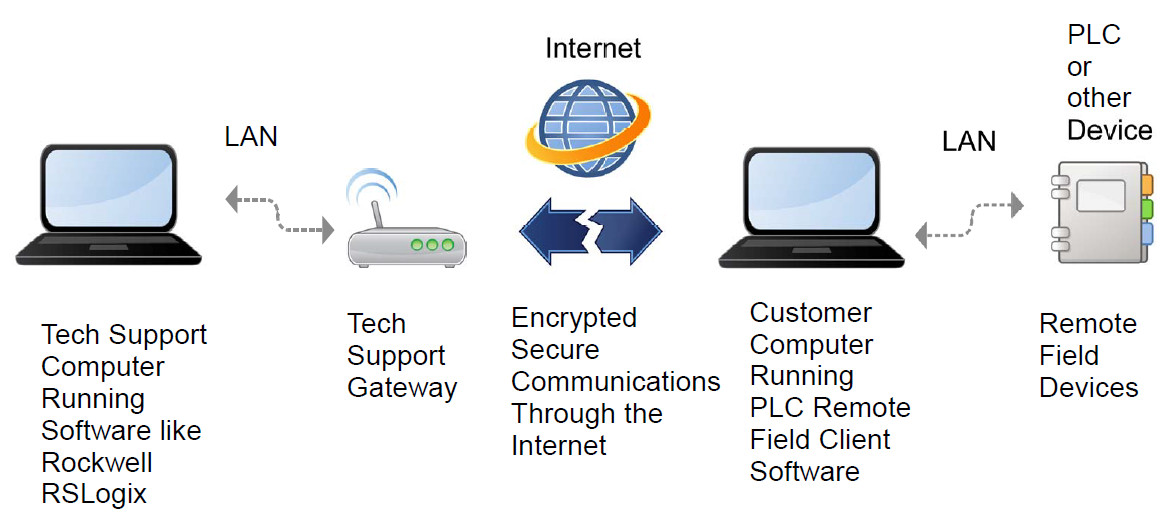Figure 1
In an example support session, after receiving a call from a new customer wanting remote support with equipment located in the field, the support person would email a copy of the PLC Remote Field Client software (included with purchase of the starter kit) to the customer. The customer would run the field client software on a computer that is attached to the internet and the local controls network (this can be on one ethernet port or on two separate ethernet ports). The support person would use the web based management software to select which type of equipment is at the remote location. For example if the remote equipment were a Rockwell PLC, then select Rockwell PLC port on the web management screen. Then the support person would start up RS Logix Software on the support computer and point it to the Tech Support Gateway device (the web based management software tells which IP address to use). Then a direct connection is made to the remote PLC and the support person can go online with the remote PLC and monitor its status or make changes as necessary.
A summary of the typical steps in a support session:
- Receive a call from a customer asking for support.
- Email the customer a copy of the Field support client to run on the customer’s local computer. The customer’s computer has access to the internet and the plc network.
- Using the plcremote access web management screen, set your device type and locate the IP address of your local Tech Support Gateway.
- Connect your programming software to the Tech Support Gateway and begin your remote support session.
plcremote.net software makes a connection to the internet cloud. Because the connections are initiated from inside of the firewalls to the internet, there is typically no hassle or configuration with the network routers or gateways needed.
plcremote has a very big advantage over VPN based solutions in that it works even if you have a duplicate IP address range on the remote side of the connection. An example of a duplicate subnet address range would be if tech support resides on a 192.168.1.XXX subnet, and the remote controls network is also on a 192.168.1.XXX subnet. This is a duplicate subnet address range and will NOT route through a VPN and therefore will not work on a VPN solution, but this will work on plcremote.
Also, the end PLC can still communicate even if it doesn’t have a gateway address or even if it doesn’t have a network gateway available to it, because the end site uses a notebook computer (typical solution used) or an optional plcremote field device to make that bridge connection to the PLC.
- plcremote can save making trips to the site where the equipment is located.
- plcremote saves the cost of purchasing and installing a copy of PLC development / programming software at the remote site.
- plcremote saves having to give customers a copy of the project source code (this can be a particularly big issue for Original Equipment Manufacturer’s – OEM’s ).
- plcremote saves having to deal with IT to setup routers or VPN’s.
- plcremote access requires no static IP addresses across the internet.
- plcremote access requires no VPN’s.
- Unlike VPN solutions, plcremote still works if you have duplicate subnet address ranges on the remote end
- plcremote provide’s a secure connection method by using an encrypted connection.
*Note that this product works with TCP/IP based ethernet communications products.
